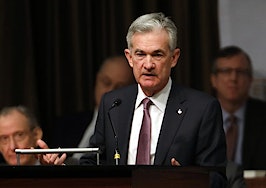The Federal Reserve raised interest rates Wednesday, marking the fourth such increase of 2018.
The Fed’s increase sets a target range for the federal funds rate of 2.25 percent to 2.5 percent. The increase of 25 basis points came as the “labor market has continued to strengthen and that economic activity has been rising at a strong rate,” according to a statement from the Fed.
“Job gains have been strong, on average, in recent months, and the unemployment rate has remained low,” the statement continued. “Household spending has continued to grow strongly, while growth of business fixed investment has moderated from its rapid pace earlier in the year.”
The increase puts interest rates at their highest levels since 2008, when the economy was being pummeled by the housing bubble and recession.
The Fed cited similar logic when it last raised interest rates, during the third quarter of 2018.
Mike Fratantoni, the chief economist at the Mortgage Bankers Association, said in a statement Wednesday that the interest rate hike was expected. He agreed that the “market is quite strong.”
However, Frantantoni also doesn’t expect more rate hikes in the immediate future, and likely only two total in 2019.
“With this additional rate hike, and with the ongoing crimping of liquidity caused by the shrinkage of the Fed’s balance sheet, we expect they will pause here for a few meetings, and will likely only hike rates twice next year,” Fratantoni said.
The Fed did not say Wednesday exactly what it would do in the future, but did explain that some additional increases could be in the pipeline.
“The Committee judges that some further gradual increases in the target range for the federal funds rate will be consistent with sustained expansion of economic activity, strong labor market conditions, and inflation near the Committee’s symmetric 2 percent objective over the medium term,” the Fed’s statement explained.
The Fed also reported that the “risks to the economic outlook are roughly balanced.”
In a statement emailed to Inman, Keller Williams senior economist Ruben Gonzalez said that “any indication” by the Fed that rates will increase more slowly “is a potential upside to housing in the short term.” Gonzales also said that recent data showed a currently healthy economy that also had “some risk to growth.”
“Overall, we see the existing home market as likely to decline in the ballpark of 2 percent next year in terms of sales with prices for existing homes rising around 3 percent,” Gonzales said.
Tendayi Kapfidze, chief economist at Lending Tree, called Wednesday’s rate increase “the best outcome,” and “a dovish hike.” He said that the hike will make credit card debt more expensive, and will also impact student loans and adjustable rate mortgages. However, in what will likely be welcome news to real estate professionals, Kapfidze said the rate hike probably won’t have a significant consequences for most homebuyers.
“Don’t expect a huge impact on mortgage rates,” he explained. “Although there is often a misconception that changes in the Fed funds rate affect mortgage rates, this is not the case. The balance sheet reduction is more important than the Fed Funds rate itself.”






